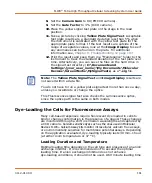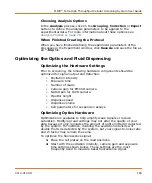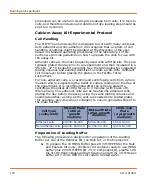
FLIPR
®
Tetra High Throughput Cellular Screening System User Guide
0112-0109 H
161
8.
Set the
Camera Gain
to 80 (EMCCD camera).
9.
Set the
Gate Factor
to 3% (ICCD camera).
10.
Place the yellow signal test plate on the stage in the read
position.
11.
Take a picture by clicking
Yellow Plate Signal Test
. Acceptable
test plate results are a standard deviation less than 5% when
the instrument is calibrated with the yellow test plate for the
appropriate plate format. If the test results are outside of the
range of acceptable values, look at the
Image Display
to see if
any anomalies can be found on the plate. For additional
information see,
Chapter 9: Troubleshooting on page 197
.
12.
Print the results and keep them in a “Maintenance” folder by the
instrument to track the standard deviation of the test plate over
time. Alternatively, you can save the files on the hard drive in
the signal test directory (
C:\Documents and
Settings\[your_user_name]\My Documents\Molecular
Devices\ScreenWorks\MySignalTests
) as a *
.sig
file.
Dye-Loading the Cells for Fluorescence Assays
Many cell-based responses require fluorescent dye loaded in cells to
bind or change conformation in the presence of a ligand. These changes
are monitored through a shift in emission wavelengths and captured by
a CCD camera.
Calcium sensitive dyes such as the ones used in Molecular
Devices
FLIPR
®
Calcium Assay kits monitor
intracellular calcium flux assays,
or environmentally sensitive for membrane potential assays. Depending
on the application evaluated, dye-loading typically lasts 30 min–1 hour
(at either room temperature or 37 °C).
Loading Duration and Temperature
Optimal loading time depends on the cell type and presence of an anion
exchange inhibitor. It is recommended not to exceed the optimal
loading time. If anion exchange inhibition does not enhance
dye-loading conditions, it should not be used. A 60 minute loading time
Note:
The
Yellow Plate Signal Test
and
Image Display
results are
not saved within a data file.
You do not have to run a yellow plate signal test more than once a day,
unless you recalibrate or change the optics.
This Fluorescence signal test also checks the Luminescence optics,
since the optics path is the same in both modes.
Summary of Contents for FLIPR Tetra
Page 1: ...FLIPR Tetra High Throughput Cellular Screening System User Guide 0112 0109 H December 2011...
Page 12: ...Contents 12 0112 0109 H...
Page 16: ...System Overview 16 0112 0109 H...
Page 40: ...System Hardware Features 40 0112 0109 H...
Page 148: ...Exchanging Hardware 148 0112 0109 H...
Page 156: ...Calibration and Signal Test 156 0112 0109 H...
Page 196: ...Running an Experiment 196 0112 0109 H...
Page 232: ...Robotic Integration 232 0112 0109 H The following drawings illustrate these requirements...
Page 282: ...Data Processing Algorithms 282 0112 0109 H...
Page 294: ...Consumables and Accessories 294 0112 0109 H...
Page 298: ...Using AquaMax Sterilant 298 0112 0109 H...
Page 302: ...Electromagnetic Compatibility EMC 302 0112 0109 H...






























